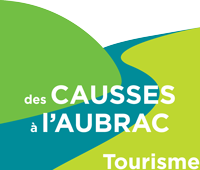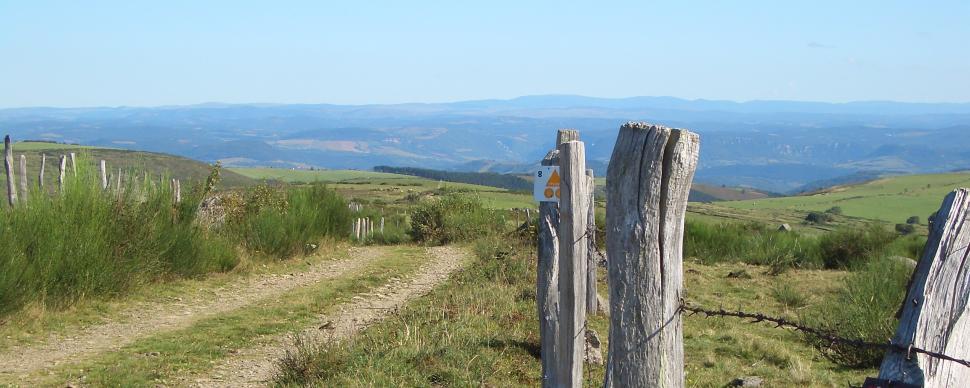L'aubrac
Terre de transhumance
Do you want to get out into the great outdoors? In any season, Aubrac is here for you!

AN ISLAND IN THE SKY
Aubrac is an island in the sky, where the horizon goes on and on.
The purity of the sky, soothing silence and deep breaths, this region is a haven of peace.
The welcome you receive adds to the rugged beauty of the landscapes.
Leaving the well-trodden path to trace your own means rediscovering forgotten sensations.
The last volcanic bastion in the Massif Central, Aubrac unfolds its immensities to infinity. A region of wide-open spaces, with pastures and beech forests, and one of the richest floras in Europe.
Finally, Aubrac is a huge natural reservoir where the water and snow accumulate before flowing in impetuous torrents - the boraldes - into the Lot.
Since May 2018, Aubrac has been a Regional Natural Park.
THE AUBRAC COWS AND TRANSHUMANCE (ESTIVE)
You can’t speak about Aubrac without mentioning the breed of cow that bears the same name?
From May to October, Aubrac bulls and beautiful cows, favourites for photographers, graze in the ‘mountains’. They are easily recognised by their plain dress, varying from fawn to wheaten grey, darker on the neckline for males. The tip of the horns and the tail are black. The muzzle and around the eye is white, outlined in black.
Even now, transhumant herds pass through our villages, accompanied by the sound of the old ‘clampas’. They take the drailles, paths bordered by stone walls, which generally follow the ridges, before reaching the pastures, with their scattered burons, or stone huts.


EVENTS TO EXPERIENCE
the Estive Festival and the Aubrac Race Festival
Our breeders are proud of their animals, and like to share their passion for the profession while respecting traditions and values.
On the Saturday closest to 25 May (St Gérault’s day), the Aubrac Breeders from the Pays d'Olt organise the great Estive Festival in St Geniez d'Olt and Aubrac, while in Laissac there is a hike with a herd, from their stable to St Geniez.
The cows are decorated with magnificent studded leather collars, flags and flowered junipers for the occasion.
They stay on the plateau until around 13 October (St Urbain’s day). Then it is the Devalada (the descent). Winter is coming...
On the 2nd Wednesday in August, the farmers also organise the Aubrac Race Festival in St Geniez d´Olt and Aubrac. Throughout the morning, the most beautiful animals are presented to the public on the old fairground.
AUBRAC 4 SEASONS
In the heart of the Aubrac Regional Natural Park, ‘Aubrac 4 seasons’ is an adventure playground for those who love the great outdoors, in any season:
Hike, whether alone or accompanied, travel on foot, mountain bike horse, scooter or electric bike.
In fine weather, fish at the Picades Lake and enjoy the picnic area in the heart of the national forest, and in winter, put on skis or snowshoes, in the Brameloup resort!
‘Aubrac 4 Seasons’ is THE outdoor family resort that will delight young and old alike, whether very sporty or more relaxed.
Take advantage of the great outdoors for extraordinary experiences!


DISCOVERIES AROUND AUBRAC
Prades d´Aubrac and its church, in the purest Gothic style...
Along the roads and paths, many crosses protected people and animals. The Bosse crosses, above St Laurent d´Olt, and the one in Le Pal, above Pomayrols, offer superb views as far as the Tarn Gorges!
The Rode Cross, surrounded by pastures, along the GR6, marking the border between Aveyron and Lozère, is the starting point to walk to the Mailhebiau signal (orientation table), the highest point in Aubrac (1469 m).
DID YOU KNOW ?
Each ‘mountain’ once had its own ‘buron’, or stone hut. Although they date back to the 14th century, their current architecture dates from the beginning of the 19th century. Built near a water point, the buron was sometimes accompanied by a pigsty, but usually not. Designed on a rectangular plan, the buron leans against a hillock and is orientated so that the cellar is buried and located to the north-east of the building.
The walls, of varying thickness (60 cm to 1 m), are built in basalt with granite stones for the corners, openings and the fireplace. The shale roofs usually have two slopes. Sometimes a cover softened the gables.


On the ground floor of the main building there is a large communal room with a fireplace where the buronniers lived and where they made cheese. It communicated with the cellar, normally vaulted, which was used for storing cheese. Upstairs, running the length of the building, an attic served both as a staff bedroom and as a hay store for the calves.
The cheese-making that took place there stemmed from an ancestral tradition. Although Pliny the Elder made mention of it, it seems that it was the monks (of Aubrac and Bonneval) who established the rules for its manufacture, from the 12th century, in order to use the summer milk production to feed pilgrims in the winter.
The buronniers curdled the unpasteurised, whole milk in the fireplace. The resulting curd was pressed once to make a fresh tome.
It was then broken, salted and put in a mould (fourme) to be pressed again for 48 hours. Then the fourme was placed in the cellar. After a minimum of 4 months of ageing, they were ready to be tasted.
OUR RECOMMENDATION
Although cheese is no longer made in the burons, some of them have been turned into restaurants. You can enjoy grilled Aubrac meat or sausages, and of course aligot and picaucel, local dishes.
From mid-June to mid-September, as part of the F’Estivales des Causses à l’Aubrac, you can meet a farmer, through the Tourist Office. They will tell you about the region and farming... The morning ends with a meal at the Buron de la Truque, where you can savour the famous aligot.




